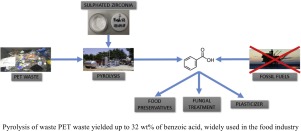当前位置:
X-MOL 学术
›
J. Anal. Appl. Pyrol.
›
论文详情
Our official English website, www.x-mol.net, welcomes your feedback! (Note: you will need to create a separate account there.)
Benzoic acid recovery via waste poly(ethylene terephthalate) (PET) catalytic pyrolysis using sulphated zirconia catalyst
Journal of Analytical and Applied Pyrolysis ( IF 6 ) Pub Date : 2018-09-01 , DOI: 10.1016/j.jaap.2018.08.014 Laura S Diaz-Silvarrey , Andrew McMahon , Anh N. Phan
Journal of Analytical and Applied Pyrolysis ( IF 6 ) Pub Date : 2018-09-01 , DOI: 10.1016/j.jaap.2018.08.014 Laura S Diaz-Silvarrey , Andrew McMahon , Anh N. Phan

|
Abstract Polyethylene terephthalate (PET) is one of the main plastics used in food packaging products, which have a very short life and are rapidly transformed into waste, and accounts for 7 wt% of the total plastic waste generated. Current PET waste management, mainly via mechanical recycling and glycolysis, have encountered a number of issues: negative impact on the environment, segregation of waste and product separation/purification. Therefore other versatile alternatives such as pyrolysis should be employed to recover value-added products from waste. Benzoic acid a precursor in the food and beverage industry, derived from PET via thermochemical conversion opposed to the current manufacturing process from fossil fuel-based feedstock is considered as a promising approach. In this study, the effect of operating conditions i.e. temperature, catalyst to plastic mass ratio and volatiles residence time and their interactions on product yields and properties were studied. Sulphated zirconia (SZ) was first time used for catalytic pyrolysis of PET due to its high acidity and environmentally friendly synthesis. Results showed that up to 27–32 wt% benzoic acid could be recovered through PET pyrolysis at 450–600 °C at 20 s residence time. By increasing the catalyst:plastic ratio to 10 wt% only 26 wt% of benzoic acid was recovered in the wax but it increased the amount of other valuable products i.e. light hydrocarbons (C1–C3) recovered in the gas.
中文翻译:

使用硫酸化氧化锆催化剂通过废聚对苯二甲酸乙二醇酯 (PET) 催化热解回收苯甲酸
摘要 聚对苯二甲酸乙二醇酯(PET)是食品包装产品中使用的主要塑料之一,其寿命极短,转化速度快,占产生的塑料垃圾总量的7%。当前的 PET 废物管理,主要是通过机械回收和糖酵解,遇到了许多问题:对环境的负面影响、废物隔离和产品分离/纯化。因此,应采用其他通用替代方法,如热解,从废物中回收增值产品。苯甲酸是食品和饮料行业的前体,通过热化学转化从 PET 中提取,与目前从化石燃料为基础的原料制造工艺相反,被认为是一种有前途的方法。在这项研究中,操作条件的影响,即温度,研究了催化剂与塑料的质量比和挥发物停留时间以及它们对产品产率和性能的相互作用。硫酸化氧化锆(SZ)由于其高酸度和环境友好的合成而首次用于 PET 的催化热解。结果表明,通过 PET 热解在 450-600 °C 下停留 20 秒,可以回收高达 27-32 wt% 的苯甲酸。通过将催化剂:塑料比率增加到 10 wt%,蜡中仅回收了 26 wt% 的苯甲酸,但它增加了其他有价值的产品,即气体中回收的轻质烃 (C1-C3) 的数量。硫酸化氧化锆(SZ)由于其高酸度和环境友好的合成而首次用于 PET 的催化热解。结果表明,通过 PET 热解在 450-600 °C 下停留 20 秒,可以回收高达 27-32 wt% 的苯甲酸。通过将催化剂:塑料比率增加到 10 wt%,蜡中仅回收了 26 wt% 的苯甲酸,但它增加了其他有价值的产品,即气体中回收的轻质烃 (C1-C3) 的数量。硫酸化氧化锆(SZ)由于其高酸度和环境友好的合成而首次用于 PET 的催化热解。结果表明,通过 PET 热解在 450-600 °C 和 20 秒的停留时间可以回收高达 27-32 wt% 的苯甲酸。通过将催化剂:塑料比率增加到 10 wt%,蜡中仅回收了 26 wt% 的苯甲酸,但它增加了其他有价值的产品,即气体中回收的轻烃 (C1-C3) 的数量。
更新日期:2018-09-01
中文翻译:

使用硫酸化氧化锆催化剂通过废聚对苯二甲酸乙二醇酯 (PET) 催化热解回收苯甲酸
摘要 聚对苯二甲酸乙二醇酯(PET)是食品包装产品中使用的主要塑料之一,其寿命极短,转化速度快,占产生的塑料垃圾总量的7%。当前的 PET 废物管理,主要是通过机械回收和糖酵解,遇到了许多问题:对环境的负面影响、废物隔离和产品分离/纯化。因此,应采用其他通用替代方法,如热解,从废物中回收增值产品。苯甲酸是食品和饮料行业的前体,通过热化学转化从 PET 中提取,与目前从化石燃料为基础的原料制造工艺相反,被认为是一种有前途的方法。在这项研究中,操作条件的影响,即温度,研究了催化剂与塑料的质量比和挥发物停留时间以及它们对产品产率和性能的相互作用。硫酸化氧化锆(SZ)由于其高酸度和环境友好的合成而首次用于 PET 的催化热解。结果表明,通过 PET 热解在 450-600 °C 下停留 20 秒,可以回收高达 27-32 wt% 的苯甲酸。通过将催化剂:塑料比率增加到 10 wt%,蜡中仅回收了 26 wt% 的苯甲酸,但它增加了其他有价值的产品,即气体中回收的轻质烃 (C1-C3) 的数量。硫酸化氧化锆(SZ)由于其高酸度和环境友好的合成而首次用于 PET 的催化热解。结果表明,通过 PET 热解在 450-600 °C 下停留 20 秒,可以回收高达 27-32 wt% 的苯甲酸。通过将催化剂:塑料比率增加到 10 wt%,蜡中仅回收了 26 wt% 的苯甲酸,但它增加了其他有价值的产品,即气体中回收的轻质烃 (C1-C3) 的数量。硫酸化氧化锆(SZ)由于其高酸度和环境友好的合成而首次用于 PET 的催化热解。结果表明,通过 PET 热解在 450-600 °C 和 20 秒的停留时间可以回收高达 27-32 wt% 的苯甲酸。通过将催化剂:塑料比率增加到 10 wt%,蜡中仅回收了 26 wt% 的苯甲酸,但它增加了其他有价值的产品,即气体中回收的轻烃 (C1-C3) 的数量。



























 京公网安备 11010802027423号
京公网安备 11010802027423号